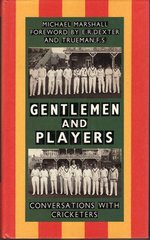Gentlemen and Players
David Mutton |Published: 1987
Pages: 362
Author: Marshall, Michael
Publisher: Grafton Books
Rating: 4 stars

It is now over fifty years since the dissolution of amateur status from the county game, and with it the last of the Gentlemen versus Players matches. These games represent the throughline of Michael Marshall’s book, in which he interviewed more than a hundred retired cricketers to gauge their experiences and opinions on the old divide between amateurs and professionals.
It is worth noting that Marshall himself was a polymath to rival the likes of C.B. Fry. A Conservative politician who rose to a junior ministerial post in the early Margaret Thatcher years, he was the first MP with an MBA from Harvard University, a high flying business executive, a cricket commentator on All India Radio, a patron of the arts, and was knighted in 1990.
Although Marshall penned a cursory introduction that dealt with the nineteenth century and Golden Age, the book focuses on the years from the end of the First World War until 1962. And although he does not offer any groundbreaking research or particularly original insights into the nature of class within cricket, Marshall provides a clear, concise account while covering a great deal of ground.
The book is structured around chapters on the Gentleman versus Players matches, county cricket more broadly and Test matches at home and abroad. Despite his political background Marshall treats the two sides of the social spectrum evenly and maintains a neutral editorial perspective. The two general themes that emerge are the increasing role of shamateurs, especially after the Second World War, and a nostalgic longing for true amateur captains, such as Percy Fender or Colin Ingleby-Mackenzie, who prefered competitive matches with friendly declarations above championship points.
The book’s subtitle, “Conversations with Cricketers”, is at the heart of the book. Marshall interviewed many cricketers of the time, and dug around press clippings and memoirs to unearth information about those who had already passed on. The result is a rich tapestry of anecdotes, akin to Stephen Chalke’s work a generation later.
There is Tom Longfield locking himself in a bedroom with the wife of his county captain, war hero Freddie Cooper addressing the shocked secretary of Lancashire, Major Howard, by his first name, and the early battles between Herbert Sutcliffe and Brian Sellers for the soul of Yorkshire cricket. Added to the trove of stories are an excellent selection of rare photos, which further add to the sense of a lost age.
Marshall maintained a clear narrative despite so many voices, in what could very easily have degenerated into a rose tinted view of the past. While he does not attempt to make sense of the class distinctions within the game, he succeeds in creating a sense of the time, and what life was like on both sides of the divide. For that reason Gentlemen and Players would enhance any cricket collection.






Leave a comment